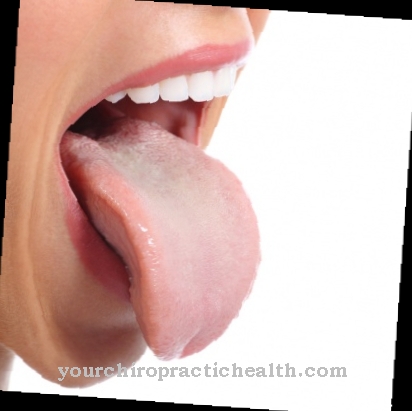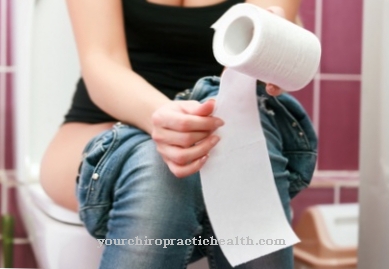Earache are mostly strong painful stimuli around the ear. These include the inner ear, middle ear, auricle and also the outer areas of the ear. Injuries, infections and inflammation are usually the cause of earache.
What is an earache?

Earache is a collective term for all forms of pain around the ear. This includes both the inner ear, the middle ear, and the outer ear. In addition, pain around the auricle is also counted as an earache.
The outer ear includes the ear canal and the ear canal bones. If swelling or inflammation occurs here, this can lead to earache. In the middle ear, however, there is more pus formation due to inflammation. If the pus does not drain properly, strong pressure can occur, which can also cause pain.
Earache can come in different forms and intensities. One knows stabbing, pressing, unilateral and bilateral earache. Sometimes they appear slowly, but sometimes they appear suddenly. Pain can also arise when chewing or when pressure is exerted on the nerves in the head and temples through glasses.
Furthermore, earache is often accompanied by other symptoms such as hearing loss, tinnitus and dizziness. Blood can flow out of the ear less often. Painkillers can only help to a limited extent against earache. Visiting a doctor is advisable.
causes
The causes of earache are manifold. The most common reasons, however, are inflammation in the outer area of the ear (ear canal) and the middle ear. In the latter case, otitis media is commonly known as part of a cold. This bacterial disease mostly affects younger children between the ages of three and seven.
Another typical cause is so-called external otitis, which is an infection of the skin of the ear canal. This leads to an infection with bacteria, which can occur as a result of excessive cleaning with cotton swabs. This bacterial infection can also be triggered by dirty water that penetrates.
Here is a list of other causes of earache:
- The ear canal is blocked by wax or dirt
- Tonsillitis or tonsillar angina
- Shingles, wound rose, allergies
Home remedies ↵ for ear
pain
- Infection and inflammation of the auricle and ear trumpet
- Pinched nerves in the area of the ear (e.g. from tight-fitting glasses)
- Diseased teeth or jaws
- Strong changes in pressure (e.g. when flying, mountaineering, driving a car in the mountains and diving, explosion or blows)
You can find your medication here
➔ Medicines for earache and inflammationDiseases with this symptom
- Sinus inflammation
- cold
- Tonsillar angina
- Otitis media
- Tonsillitis
- Shingles
- Eardrum injuries
- Sore rose
- allergy
Complications
Earache usually goes without major complications. However, if the symptoms are due to a serious underlying disease such as otitis media, the entire ear canal and, later, the meninges can become inflamed. In addition to paralysis of the facial nerves and meningitis, serious brain abscesses are among the possible complications of a severe course.
In rare cases, the bacteria migrate into the inner ear and cause what is known as toxic labyrinthitis with tinnitus, dizziness and disturbances of balance. Finally, complete hearing loss can also occur. If the cause is a disease in the jaw and tooth area, if left untreated, inflammation can occur; There are other risks associated with an abscess in the mouth and throat.
Complications rarely arise during treatment. In addition to drug intolerance or complications during surgery, home remedies such as ear swabs or ear rinses can also harbor dangers, especially if they are used without consulting a doctor. To avoid complications, any treatment steps should first be discussed with the responsible doctor. A risk-free treatment of the earache is possible in most cases after clarification of the underlying disease.
When should you go to the doctor?
Extreme caution is required with earache, because this clinical picture is associated with a large number of complications. In most cases, ear pain is the result of an infection caused by bacteria inside the ear. Affected persons can use some home remedies or their own medicine cabinet at the first signs. However, if there is no significant improvement after one or two days, a visit to the doctor is urgently recommended.
It makes absolutely no difference whether you go to your own family doctor or an ear doctor, as long as it is an otitis media. A doctor will prescribe medication for the affected person that will effectively and quickly relieve the earache. However, if such treatment is omitted, then there is a risk of dangerous and significant complications. The infection can possibly spread throughout the body, causing further symptoms. This includes a general malaise, headache, high temperature or chills.
So if you want to avoid the symptoms mentioned, you should consult a doctor early on. Early treatment can be beneficial as soon as the first signs of earache appear. In this way, the inflammation is inhibited from the start so that the infection cannot spread any further.
Doctors & therapists in your area
Treatment & Therapy
Treatment for ear pain should always be carried out by a doctor or ear, nose and throat doctor. First, the doctor will ask the patient about their pain. Then he will examine the auricle and the ear canal more closely. An otoscopy may also be necessary.
The ENT doctor can examine hearing loss and blockages of the ear with a tube function test. Hearing tests can also be used for further diagnosis. If the cause is still unclear, an X-ray can provide further information. Blood tests and swabs of the inner walls of the ear can also provide further information about the causes of the earache.
Depending on the cause, treatment is then initiated. If the ears are inflamed, anti-inflammatory ointments can be used. Once the infection has progressed, antibiotics can also be prescribed.
Ear drops are mostly used in the course of otitis media, which are both anti-inflammatory and analgesic. Sometimes the eardrum has to be cut in order to drain the pus that has formed.
Ear wax and foreign bodies are removed by the ENT doctor using medical instruments. If the eardrum is injured, it usually heals on its own in one to two weeks. However, if complications arise, an artificial eardrum can also be used surgically.
If the earache is only a side effect of various other underlying diseases, these should be treated primarily.
Outlook & forecast
In many cases, earache can be treated relatively well and therefore does not have to lead to a reduced quality of life. They often appear as an accompanying symptom with colds or the flu and usually disappear again even when the patient is completely healthy. No direct treatment is necessary for this temporary earache. Here the ear needs to be given warmth and calm in order to regenerate.
However, if the earache persists or occurs after an accident, it is essential to consult a doctor. In the worst case scenario, it can lead to severe inflammation in the ear. This inflammation can adversely affect hearing, which can lead to hearing loss.
The earache can also indicate an injury to the eardrum. It is not uncommon for the earache to occur when the patient has pain in the head or teeth. In these cases the earache cannot be treated directly, but disappears with the treatment of the pain that caused it.
An otitis media can be cured relatively well and usually does not lead to further complaints or complications. In most cases, however, ear pain is temporary and disappears after a short time.
You can find your medication here
➔ Medicines for earache and inflammationYou can do that yourself
Persistent earache always requires a medical examination. Acute complaints, such as those that can occur when landing in an airplane or when coming into contact with drafts, can be alleviated by regular, conscious swallowing, chewing gum or equalizing the pressure. In addition, nasal drops or sprays can be used.
Earache caused by clogged ears can be reduced with baby oil or gentle jaw movements, while the easiest way to relieve pain caused by a cold is bed rest and plenty of drinking. In addition, various home remedies and measures can reduce the symptoms. As a first aid measure, we recommend a warm compress with honey or chopped onions, which is placed directly behind the ear. Alternatively, other warm or hot applications such as ear steam, heated oil or chamomile cushions can also be used.
In the case of acute pain, a cold compress or Prießnitz wrap on the ear is recommended, which can be combined with healing earth or herbal tea at the beginning of the inflammation. In addition, the ears should be protected from the cold, moisture or drafts so that any inflammation can heal quickly. In order to avoid earache in the first place, the immune system should be strengthened through a vitamin-rich and balanced diet.
























.jpg)



